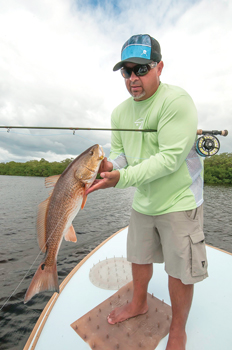The miracle of Matlacha

rUSTY CHINNIS | sun
Rick Hess unhooks a redfish that fell for a
spoon fly.
Gossamer veils of mist driven by a cool, damp north wind greeted us as we motored into Matlacha Pass. The weather had morphed overnight, from warm fall to early winter with the arrival of a cold front. The wind was gusting to twenty miles an hour and Captain Joe Harley was pondering his game plan.
The trip had been planned a month before and Harley had mapped out a strategy based on prolific fishing he had been experiencing throughout the Matlacha Aquatic Preserve (AP). The change of weather required Harley to access his memory. The 300-plus days he spends on the water every year would prove invaluable.
Rick Hess joined us on our outing. His pin point casts and stamina proved invaluable with the poor visibility we encountered. Over nearly 16 hours, Hess made thousands of casts to and under the mangroves. This was the place we had most of our action.
Having pre-fished for a number of days, Harley had been intent on discovering a pattern that would assure our success. The early front completely changed the pattern he had so carefully mapped out. Not to be dissuaded, he changed his plan to address the conditions.
Located between Boca Grande Pass and Fort Myers Beach, the Matlacha AP features a diverse habitat, offering some of the most productive sport fishing in the State.
Our first stop was in a protected canal that had evaded the development that was originally planned. Harley had chosen the spot because it was protected from the wind. The canal was inaccessible on low water. Harley shut the motor down at the mouth of the canal and we immediately saw tarpon rolling in the distance. Hess was fishing an eight weight outfit with a floating line, a nine-foot tapered leader and a forty pound bite tippet. Harley had suggested a brown Clouser which Hess tied on with a non-slip mono loop. As skiff moved silently down the canal Hess cast to pods of rolling fish. Most of the tarpon weren’t in a mood to feed, but we still managed hook one that escaped in an acrobatic leap. The next day we returned to the same canal and landed a beautiful fish.
Our next stop was across the Pass where the Burnt Store Bar intersects with Matlacha Pass and Charlotte Harbor. Here a plethora of small islands feature excellent habitat for all the varied species that inhabit the local waters. Poling the edges of the mangroves we saw and cast to some large snook and reds that refused our flies.
Heading south of the Matlacha Bridge Harley took us to a large flat near where we worked the mangroves. Hess was on the bow when he noticed a swirl behind the boat. Turning and making a cast he was rewarded with a fat red that was over the 36-inch slot. Moving further south we found more reds. Because the visibility was so poor, Harley looked for an area that had large schools of mullet. Reds like to cruise with mullet, perhaps using them for cover. When the visibility is poor or if the water is muddy due to the mullet Harley likes to use a spoon fly which act as an attractor pattern. After just a few minutes Hess connected with another red that took him fifty yards into his backing. Fifteen minutes later another red fell for the spoon fly.
The only fish that evaded us was a snook and it wasn’t until the last stop of the last day that Hess connected with one under a mangrove bough. The snook put up a signature battle with several strong runs and numerous head shaking jumps. After boating and photographing it we called it a day.
The trip was challenging but we still managed to catch the snook, redfish and tarpon we were targeting. It proved that even under the most challenging conditions the Matlacha Pass Aquatic Preserve’s rich and varied habitat ranks as one of the best Florida has to offer.
Captain Joe Harley can be reached by phone at 239-443-7412 or e-mail joe@snooktown.com.

